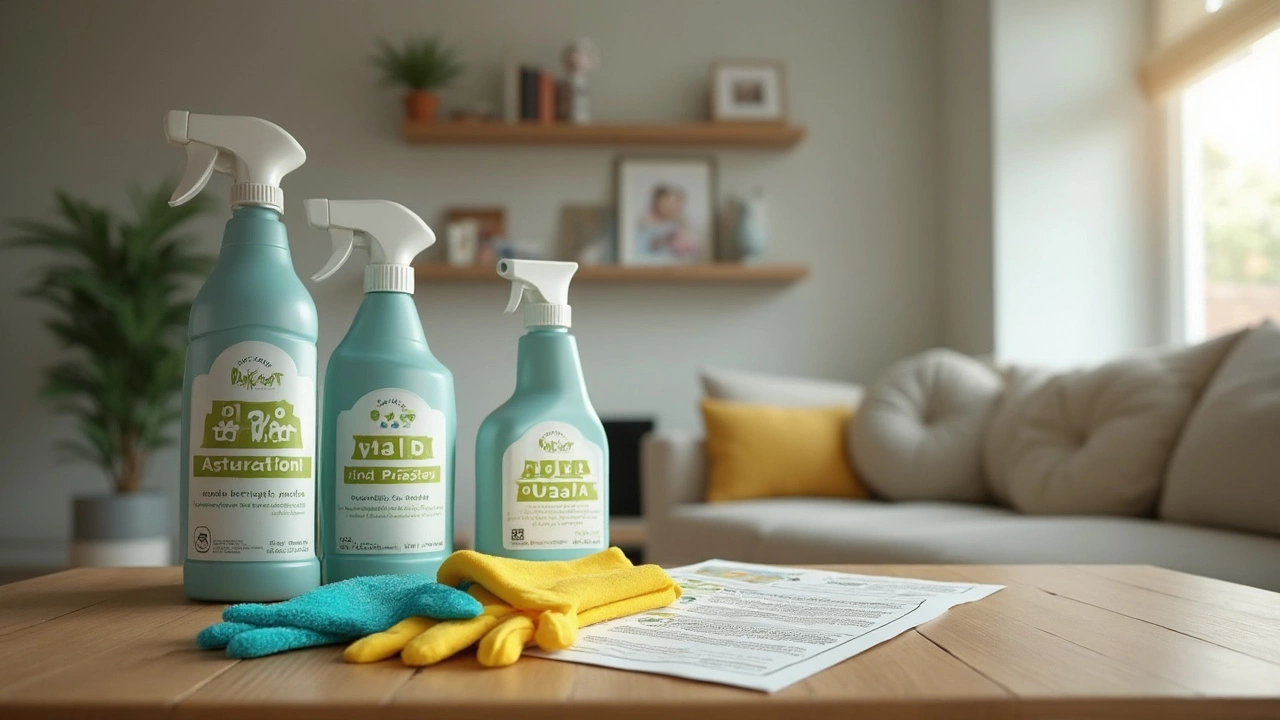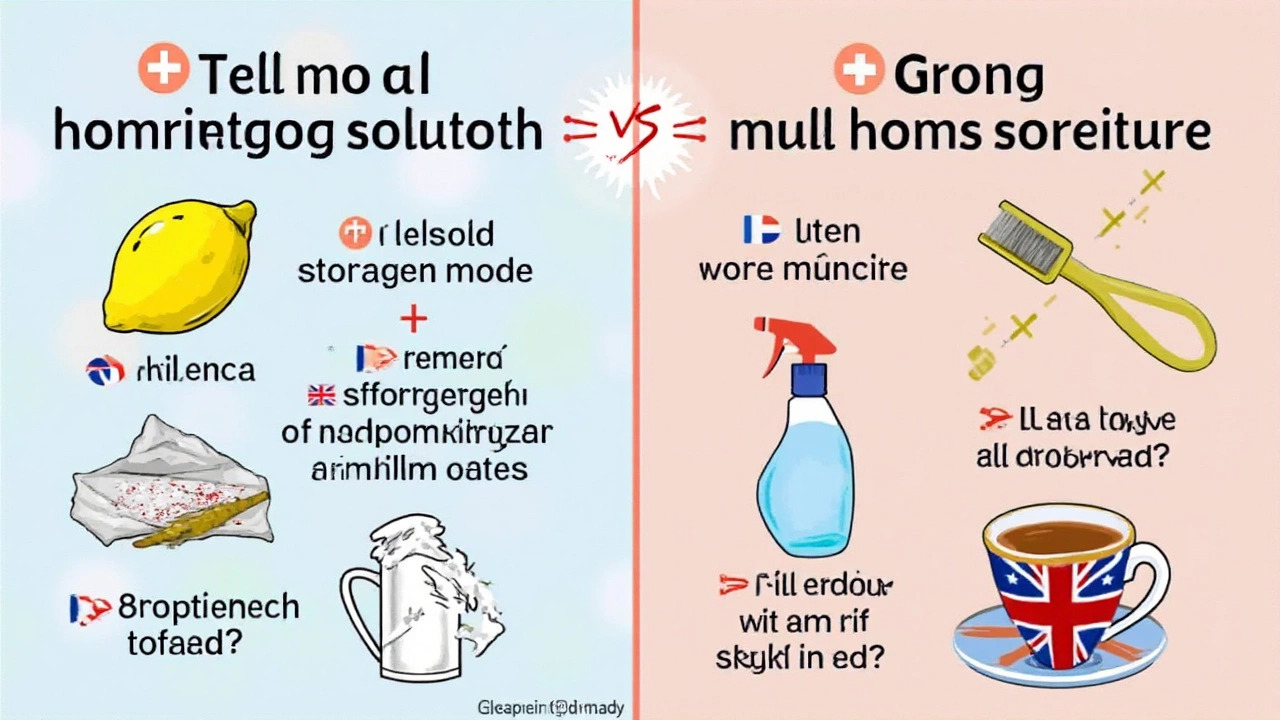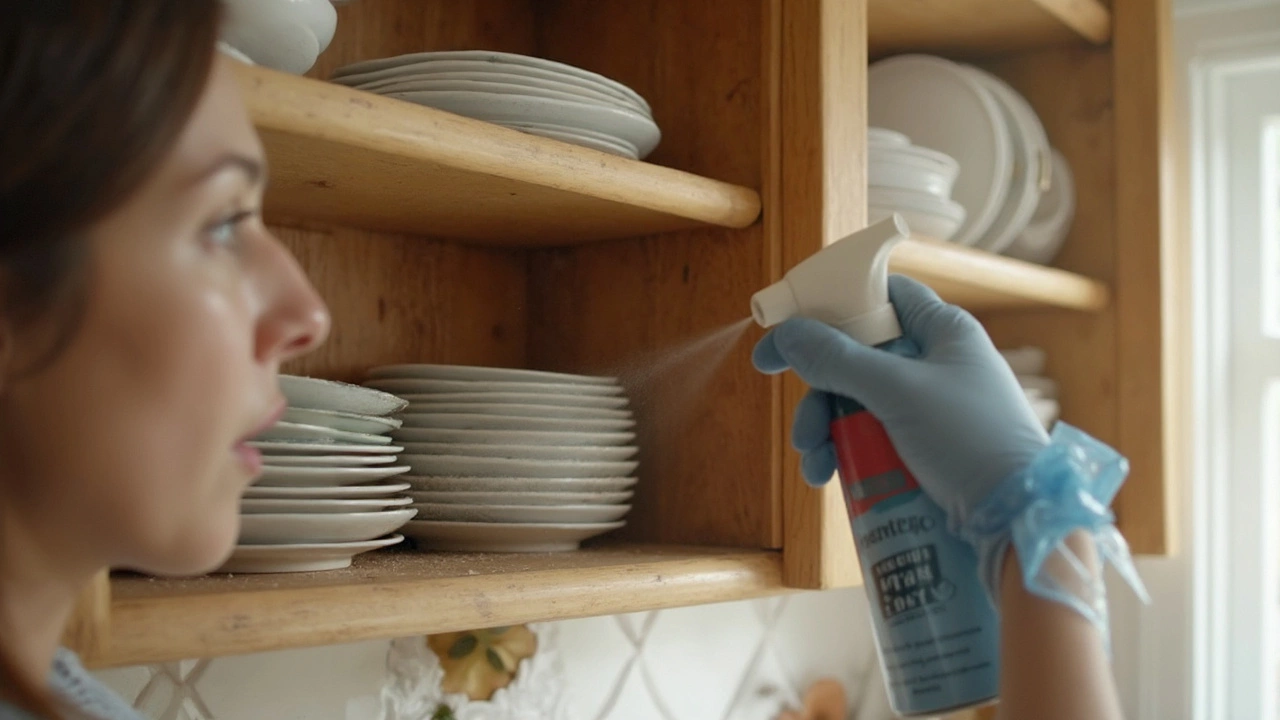Mold doesn’t just mess with your stuff—it ruins it. Once that musty smell hits your nose, it means spores are already breaking down wood, fabric, or whatever’s hiding in your furniture. Some folks try wiping mold away, but the ugly truth? Mold doesn’t care. If you don’t kill it right down to the roots, it'll come back, usually stronger.
You might’ve heard bleach is the go-to fix for mold, but that’s not the full story. Bleach only wipes out surface mold on hard, non-porous materials. On wood, particle board, or woven baskets, bleach can’t reach deep enough. The mold hangs out in tiny cracks and pores, just waiting for a little moisture to make its comeback.
- How Mold Takes Over Storage Furniture
- Why Bleach Isn't the Miracle Mold Killer
- The Only Methods That Actually Kill All Mold
- Safe Cleaning Tips for Different Furniture Materials
- Keeping Mold Away for Good
How Mold Takes Over Storage Furniture
Mold shows up when you mix moisture, warmth, and darkness—pretty much the perfect combo hiding inside every old cabinet, closet, or chest. Basements, garages, even closets get humid. It only takes about 24 to 48 hours for mold spores floating in the air to land on your furniture and get to work.
Here’s a quick look at what mold really needs to wreck your storage furniture:
- Moisture, even from humidity or tiny spills
- Materials like wood, MDF, or fabric that soak up water
- Stale air—the less circulation, the easier it is for mold to grow
- Spots people forget to check, like behind or underneath furniture
Clutter makes it worse. Piles of clothes or stacked boxes trap moisture and block air, turning a wardrobe or dresser into mold’s dream home. Once mold finds a good spot, it releases chemicals that break down the surface and dig in deep. That’s why that mildew smell lingers, even after you clean—what you’re smelling are those chemicals, some of which aren’t great for your lungs.
One eye-opening study by the Environmental Protection Agency (EPA) found that indoor humidity over 60% almost always leads to visible mold after a week. Here’s how the risk changes depending on the conditions:
| Condition | Mold Growth (Days) |
|---|---|
| Humidity above 60% | 2-7 |
| No air flow (closed doors) | 3-6 |
| Direct sunlight | Rare, if ever |
Just wiping away stains won’t stop the spores. Mold sends its roots into porous spots, so if you’re dealing with wood or fabric, it goes further than the eye can see. When someone talks about mold removal, it’s all about killing those hidden spores, not just the patches on the surface.
Why Bleach Isn't the Miracle Mold Killer
Bleach gets tossed around as the best weapon against mold, especially on storage furniture. But here’s the kicker: it barely scratches the surface—literally. Bleach works well on smooth, non-porous surfaces like glass or tile. For porous stuff like wood or MDF, it’s a different story. The chlorine in bleach stays on top, while the water part soaks in. This can actually push mold roots even deeper into the furniture.
Most people don’t realize that bleach is basically useless once mold digests itself into cracks and fibers. Studies from the EPA and CDC have shown that while bleach can make the mold removal job look good from the outside, it doesn’t kill the hidden mold underneath. Sometimes, it even makes it easier for spores to come back, since the bleach can damage the surface but not the source.
Another thing: bleach fumes are tough on your lungs and can ruin finishes or paint on your furniture. If you’re using it on indoor household items, you’re often just trading one problem for another. Better options are out there that actually reach the deep roots of mold, without all the side effects.
- Avoid using bleach on wood or any material that can soak up moisture.
- If you do use bleach, it will only help on fully sealed surfaces—think plastic, glass, or metal.
- For anything porous, look for cleaners specifically made to penetrate and kill mold at the source, like hydrogen peroxide or commercial enzymatic products.
At the end of the day, bleach might save you time on a quick cleanup, but it won’t keep the mold away on storage furniture. You need something stronger—something that works from the inside out.

The Only Methods That Actually Kill All Mold
If you’re hoping for a magic spray to tackle every mold problem, you’re out of luck. Killing mold removal is about getting rid of every living spore, even the ones you can’t see. Mold thrives in tiny cracks, and most store-bought cleaners just don’t go deep enough. Here’s what science actually says about what gets the job done.
You want to use products or methods that destroy spores—not just wipe off what’s on the surface. According to the U.S. Environmental Protection Agency (EPA), these are the only solutions that have been proven to kill 100% of mold when used the right way:
- Concrobium Mold Control: This product actually crushes and eliminates mold at the root. It’s safe for most surfaces, including wood and fabric. Just spray, let dry, and you’re done—no rinsing needed.
- Hydrogen Peroxide (3% Solution): Great for both porous and non-porous materials. Spray on, wait 10-15 minutes, then scrub and wipe dry. Hydrogen peroxide kills the whole colony, not just the top layer.
- White Vinegar: Surprisingly strong. Even though it smells bad, vinegar kills about 82% of mold species. Let it sit on the surface for at least an hour, then wipe.
- Professional-Grade Fungicides: These get used by pros during serious outbreaks. They cost more, but for heavy mold in storage furniture, nothing works better—and yes, even the tough black mold doesn’t stand a chance.
Heat treatment is another way to destroy all mold, especially for smaller, portable pieces. Mold dies at temperatures above 140°F (about 60°C). Leave the furniture in a hot, sunny car for several hours, or use a steam cleaner if your material can take the heat. Always check the furniture won’t warp or melt before trying this.
Here’s a quick look at how well these methods work, based on real lab data:
| Method | Mold Removal Rate | Safe for Porous Materials? |
|---|---|---|
| Concrobium | 99.9%-100% | Yes |
| Hydrogen Peroxide | 99.8%-100% | Yes |
| White Vinegar | 70%-82% | Yes |
| Baking Soda (Not listed above but often used) | 60%-70% | Yes |
| Professional Fungicides | 100% | Yes |
| Heat Treatment | 99%-100% | Yes (if safe for material) |
When killing mold, always wear gloves and a mask. Mold spores are no joke for your lungs. If mold covers a huge area (over 10 square feet), don’t tackle it alone—call in pros with the right gear for full mold removal. And for any cleaner, test somewhere hidden first. You don’t want to ruin your shelf while trying to save it.
Safe Cleaning Tips for Different Furniture Materials
Not all storage furniture takes the same kind of beating from mold removal methods. What works on one piece might wreck another. Here’s what you should know before you break out the cleaners and brushes.
Wood: Mold loves wood because it soaks up moisture. Don’t use bleach—it barely makes a dent below the surface and might damage finishes. Instead, mix equal parts white vinegar and water. Dampen a cloth and scrub the spot. Let it air dry completely. For deep mold, a tiny bit of 3% hydrogen peroxide can get further inside. Do a patch test first.
Metal: Metal shelves or cabinets are easier. Wipe them down with hot, soapy water, followed by a swipe of undiluted vinegar. Dry thoroughly to avoid rust. Make sure joints and corners get extra attention—they often hide spores.
Plastic: Go with a solution of dish soap and warm water. For stubborn mold, add a splash of vinegar or use a non-abrasive scrubbing pad. Rinse well and leave to dry in sunlight if possible, since UV rays zap remaining spores.
Fabric bins or cushions: Take these outside if you can. Brush off dry mold. Wash in hot water with a cup of vinegar or a mold-busting detergent. If the fabric isn’t washable, it’s usually safer to toss it. Moldy fabrics hold onto spores longer than you might think.
Here’s a quick cheat sheet for mold cleaning methods:
| Material | Best Cleaner | Extra Step |
|---|---|---|
| Wood | Vinegar + water | Hydrogen peroxide (stubborn spots) |
| Metal | Soap + water | Wipe with vinegar, dry fast |
| Plastic | Soap + water | Sun-dry |
| Fabric | Hot water + vinegar | Replace if still moldy |
Never mix bleach with ammonia or vinegar—the fumes are dangerous. Always wear gloves and open a window. Seriously, mold can cause breathing problems if you mess with it indoors. If mold has eaten deep into particle board or foam, chuck it out. Spores can burrow in and spread right back through your stuff, even after cleaning. Think of cleaning as your way to save what can actually be saved without taking risks.

Keeping Mold Away for Good
Nobody wants to kill mold today only to find it back a week later. The cold truth? Without changing a few habits or fixing some common problems, you’re basically inviting mold to return. The best defense is making your storage furniture a place mold hates to live.
First, keep things dry. Mold absolutely loves damp, dark spots, so controlling moisture is non-negotiable. Aim for humidity below 50%. In fact, studies from the EPA show that once humidity creeps over 60%, mold growth becomes almost a sure thing.
- Use a dehumidifier in basements or closets where storage furniture sits.
- Run fans or open windows to let air move, especially after cleaning spills.
- Store furniture away from outside-facing walls or pipes that sweat.
- Clean up leaks or drips—fast. Mold can start in just 24-48 hours on wet surfaces.
Prevention beats any cleaner out there. To really keep your furniture safe, consider products that block moisture, like silica gel packs or moisture-absorbing tubs. Throw a couple into storage bins or behind furniture, and swap them out when they get full.
If you want hard numbers, check out this quick guide:
| Humidity (%) | Mold Growth Risk |
|---|---|
| < 40% | Very low |
| 40-50% | Low |
| 50-60% | Medium |
| > 60% | High |
It’s smart to inspect storage areas every month. Pull furniture forward, check behind and underneath for damp spots or discoloration, and sniff for that telltale musty smell. Catching it early is ten times easier than battling a full-blown outbreak.
Last tip: Don’t pile stuff on top of cabinets or fill drawers to the brim. Overpacked furniture traps humidity. Give your storage furniture some breathing space. Less crammed = less chance for mold to party. Stay on top of these habits and you’ll keep your storage clean and worry-free.


Write a comment